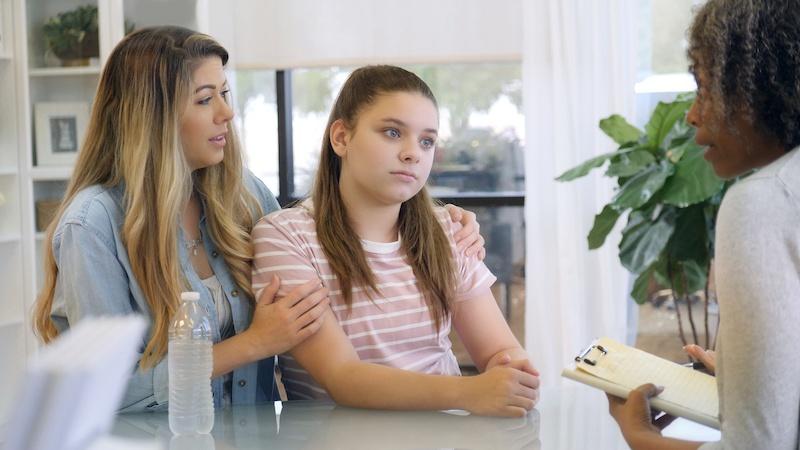“Step into the world of step-family therapy and discover a new perspective on blended families. Whether you’re a newlywed or have been in your stepfamily for years, this type of therapy can help navigate the challenges that come with combining two families into one. From establishing boundaries to building stronger relationships, we’ll explore all there is to know about step-family therapy and how it can benefit you and your loved ones.”
Contents
What Is Step-Family Therapy?

Step-family therapy is a form of therapy that focuses on the unique challenges that arise in blended families. Blended families are those that are formed when two people with children from previous relationships come together to form a new family unit.
This family therapy is designed to help stepfamilies navigate the complex dynamics that arise in these situations. This type of therapy can help family members learn to communicate effectively, develop healthy boundaries, manage conflicts, and build stronger relationships with one another.
Some common issues that stepfamily therapy may address include:
- Parenting conflicts
- Loyalty conflicts
- Discipline issues
- Communication breakdowns
- Struggles with identity and belonging
- Managing relationships with ex-spouses and extended family members
Step-family therapy typically involves multiple family members, including both biological and step-parents and children. The therapist will work with the family to identify areas of conflict and help them develop strategies to manage these issues healthily and constructively.
Goals of Step-Family Therapy
The goals of step-family therapy may vary depending on the specific needs and circumstances of the family, but some common goals include:
- Improving communication: One of the main goals of step-family therapy is to improve communication between family members. This may involve helping family members learn to listen to one another, express themselves effectively, and avoid misunderstandings.
- Building stronger relationships: Step-family therapy can help family members develop stronger, more positive relationships with one another. This may involve learning to appreciate each other’s strengths and differences, building trust, and creating a sense of unity within the family.
- Managing conflicts: Conflict is a natural part of any family dynamic, but stepfamilies may face unique challenges in this area. Step-family therapy can help family members learn to manage conflicts constructively, without resorting to harmful or destructive behaviors.
- Developing healthy boundaries: This family therapy can help family members establish healthy boundaries and clarify expectations within the family. This can help reduce tension and conflict and promote a more positive family environment.
- Addressing individual and family needs: Step-family therapy can also help family members identify and address individual and family needs. This may involve addressing issues related to parenting, discipline, loyalty, or identity, and helping family members work together to find solutions that work for everyone.
Ultimately, the goal of step-family therapy is to help blended families navigate the unique challenges that arise in these situations and build stronger, more positive relationships with one another.
Who Can Benefit from Step-Family Therapy?

Additionally, step-family therapy can provide a safe space for family members to express their feelings and concerns and constructively work through difficult issues.
Some specific situations where this family therapy may be particularly beneficial include:
- Blended families with young children: Young children may struggle to adjust to new family dynamics, particularly when there are step-siblings involved. Step-family therapy can help parents and children learn to communicate effectively and develop positive relationships with one another.
- Families with complex dynamics: Blended families that involve ex-spouses, extended family members, or significant age differences may face additional challenges. Step-family therapy can help families navigate these complex dynamics and develop strategies for managing conflicts and building stronger relationships.
- Families facing major life changes: Major life changes such as remarriage, relocation, or the birth of a new child can be particularly challenging for blended families. Step-family therapy can provide support and guidance as families navigate these transitions.
Overall, anyone who is part of a blended family and is experiencing challenges related to family dynamics, communication, or relationships can benefit from step-family therapy.
What Happens In Step-Family Therapy?

The structure and content of a step-family therapy session may vary depending on the needs and circumstances of the family, but some general elements are typically included. Here are some things that may happen in this family therapy session:
- Establishing goals: At the beginning of therapy, the therapist will work with the family to identify their goals for therapy. This may involve discussing specific issues that the family is experiencing and identifying areas where they would like to see improvement.
- Exploring family dynamics: The therapist will work to understand the unique dynamics of the family, including the relationships between family members, communication patterns, and sources of tension or conflict.
- Developing strategies: Based on the goals and dynamics identified in therapy, the therapist will work with the family to develop strategies for improving communication, managing conflict, and building stronger relationships with one another.
- Practicing new skills: To make lasting changes, family members will need to practice new skills and behaviors outside of therapy sessions. The therapist may provide exercises or activities for family members to complete between sessions to reinforce the skills they are learning in therapy.
- Monitoring progress: Throughout therapy, the therapist will monitor the family’s progress toward their goals and make adjustments to the therapy plan as needed. This may involve revisiting earlier topics, exploring new issues as they arise, or modifying therapy techniques to better meet the family’s needs.
Techniques Used In Step-Family Therapy
There are a variety of techniques that may be used in this-family therapy, depending on the specific needs and circumstances of the family. Some common techniques include:
- Family systems therapy: This approach focuses on understanding the family as a whole, rather than individual family members. It emphasizes the interconnectedness of family members and the impact of family dynamics on individual behavior.
- Cognitive-behavioral therapy (CBT): CBT is a goal-oriented therapy that focuses on changing negative thought patterns and behaviors. In step-family therapy, CBT may be used to help family members identify negative thought patterns related to their family situation and develop more positive ways of thinking.
- Solution-focused therapy: This approach emphasizes finding solutions to specific problems, rather than exploring the underlying causes of those problems. In step-family therapy, solution-focused therapy may be used to help family members identify specific issues that need to be addressed and develop strategies for resolving those issues.
- Play therapy: Play therapy can be a helpful technique for working with children in step-family therapy. It allows children to express themselves in a non-verbal way and can help them process difficult emotions related to their family situation.
- Narrative therapy: This approach involves exploring the stories that individuals tell about themselves and their families. In step-family therapy, narrative therapy may be used to help family members reframe their understanding of their family situation and develop more positive narratives.
Overall, the specific techniques used in step-family therapy will depend on the unique needs and circumstances of the family. A skilled therapist will work with the family to identify the most effective strategies for achieving their goals and improving their relationships.
Limitations of Step-Family Therapy

While step-family therapy can be highly effective for many families, there are some limitations to keep in mind. Here are some potential limitations of step-family therapy:
- Resistance to therapy: Some family members may be resistant to the idea of therapy or may be skeptical about its potential benefits. This can make it challenging to engage everyone in the therapy process and may limit the effectiveness of therapy.
- The complexity of family dynamics: Blended families can be highly complex, with multiple relationships and dynamics to navigate. This complexity can make it challenging to identify and address all of the issues that may be contributing to tension or conflict within the family.
- Limited resources: Access to quality step-family therapy may be limited in some areas, particularly in rural or low-income communities. This can make it difficult for some families to access the support they need.
- Lack of motivation: Family members may lack the motivation to make changes or put in the effort required to improve their relationships. This can limit the effectiveness of therapy if family members are not fully invested in the process.
- Outside influences: The success of step-family therapy can also be influenced by factors outside of therapy, such as ongoing conflicts with ex-spouses or financial stress. These external factors can make it difficult for families to fully implement the changes they are working on in therapy.
Conclusion
Step-family therapy is a valuable and effective way to help blended families navigate their unique challenges. It can provide the tools and support needed for step-families to create a healthier environment and foster stronger relationships between family members. With the guidance of an experienced therapist, stepparents and children can work together to build trust, form closer bonds, and develop greater understanding within the family unit.
We hope this article has helped you better understand what step-family therapy entails so that you can make an informed decision about whether it’s right for your family.
For more information, please contact MantraCare. Parenting is a challenging yet rewarding experience that is crucial for the development and well-being of a child. If you have any queries regarding Online Parenting Counseling experienced therapists at MantraCare can help: Book a trial therapy session



